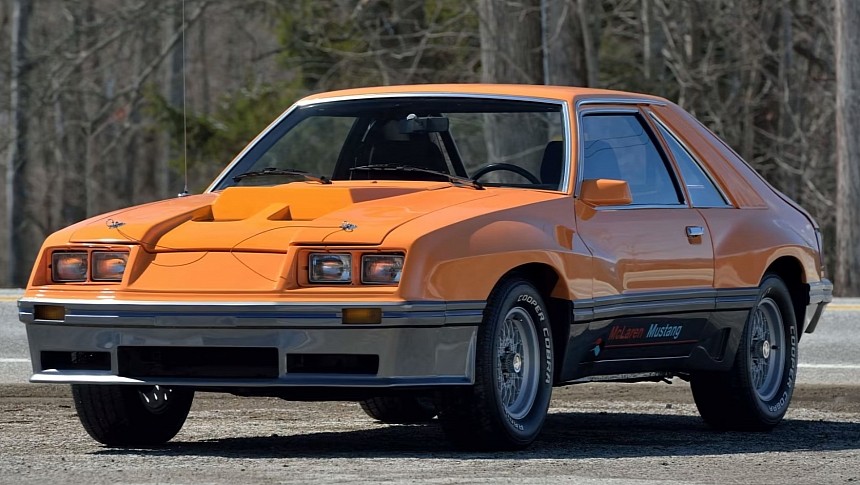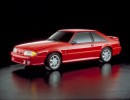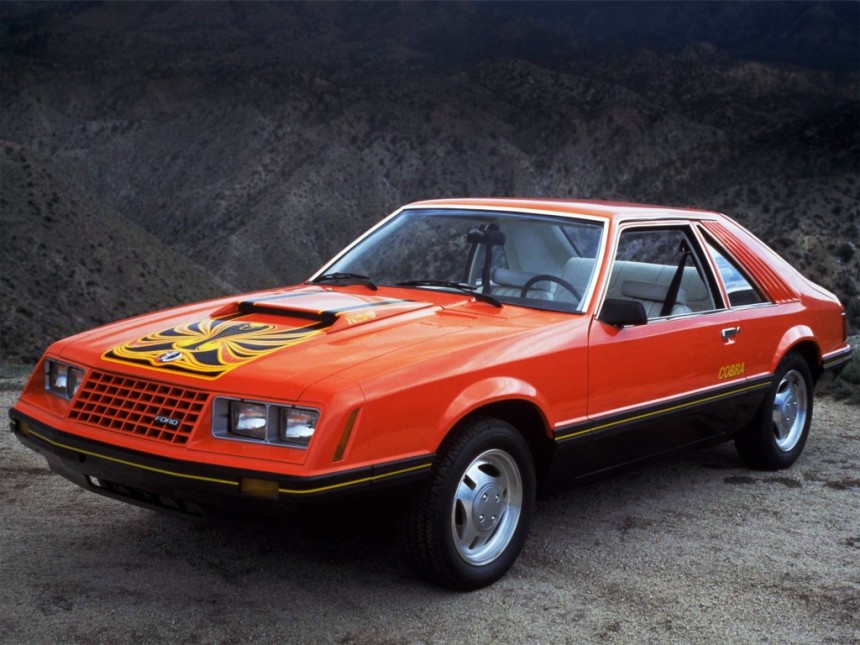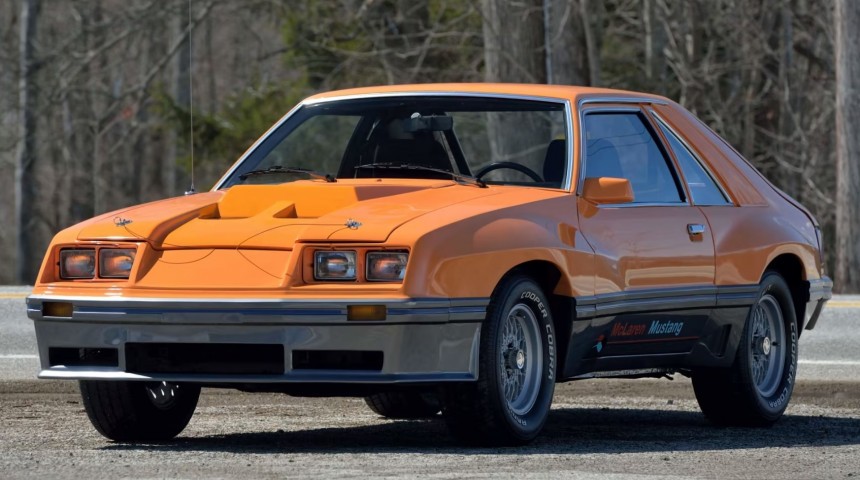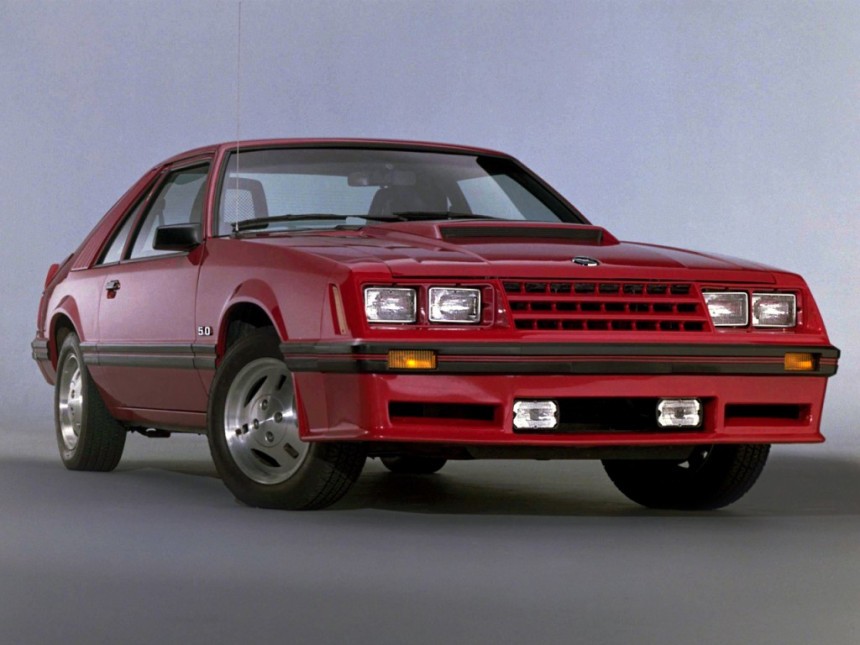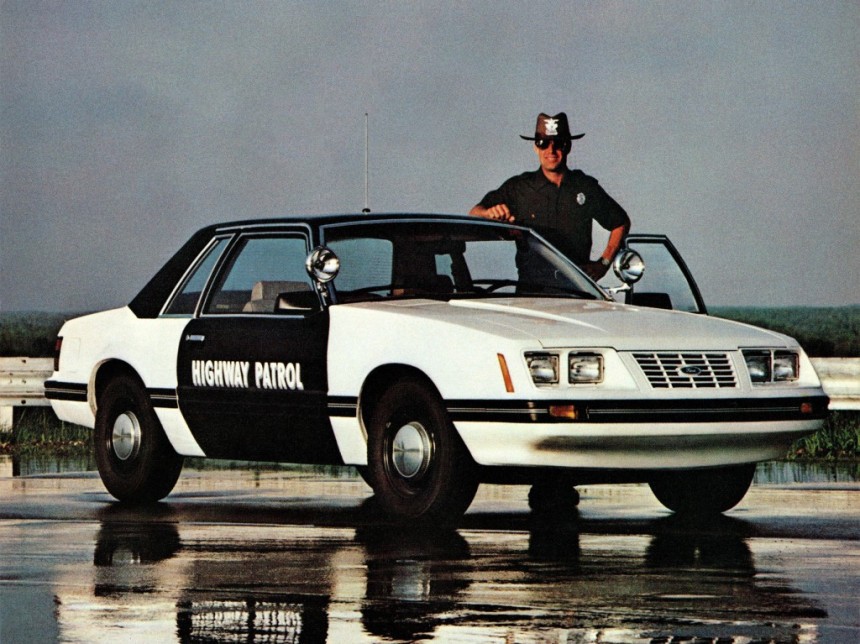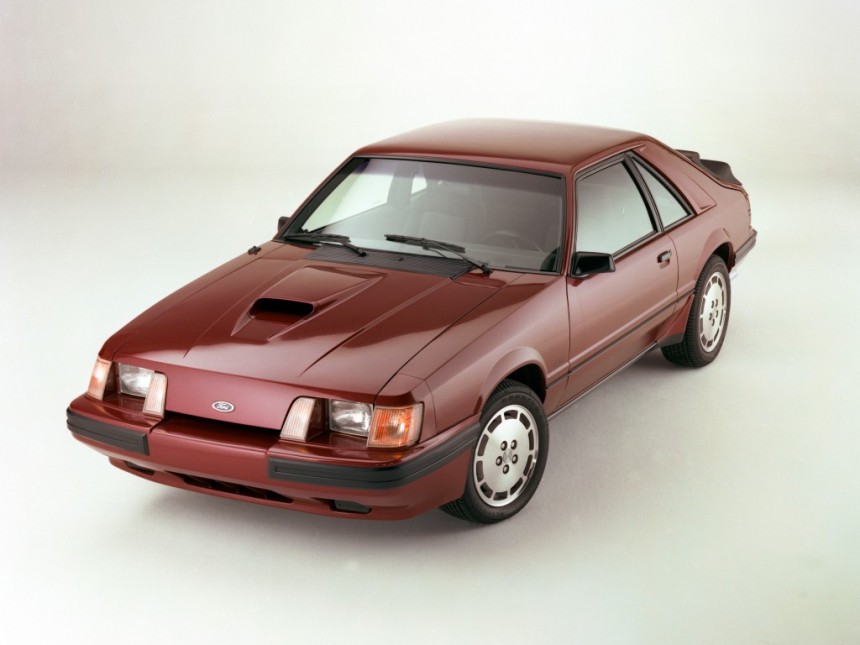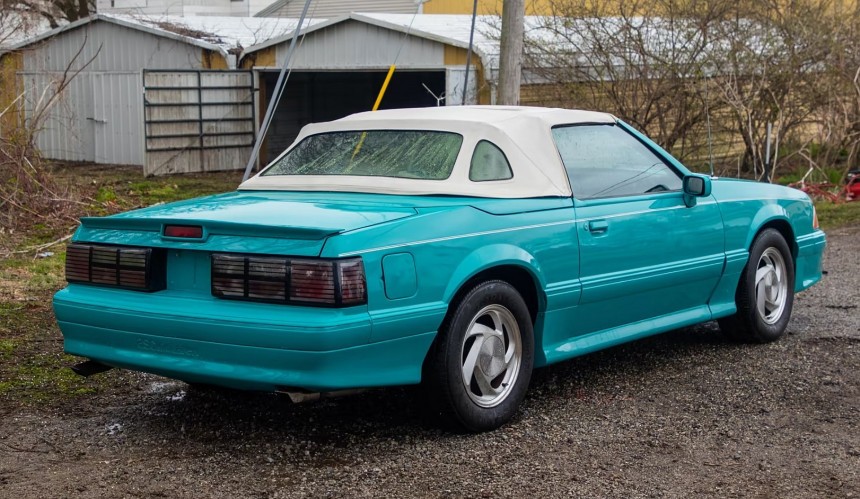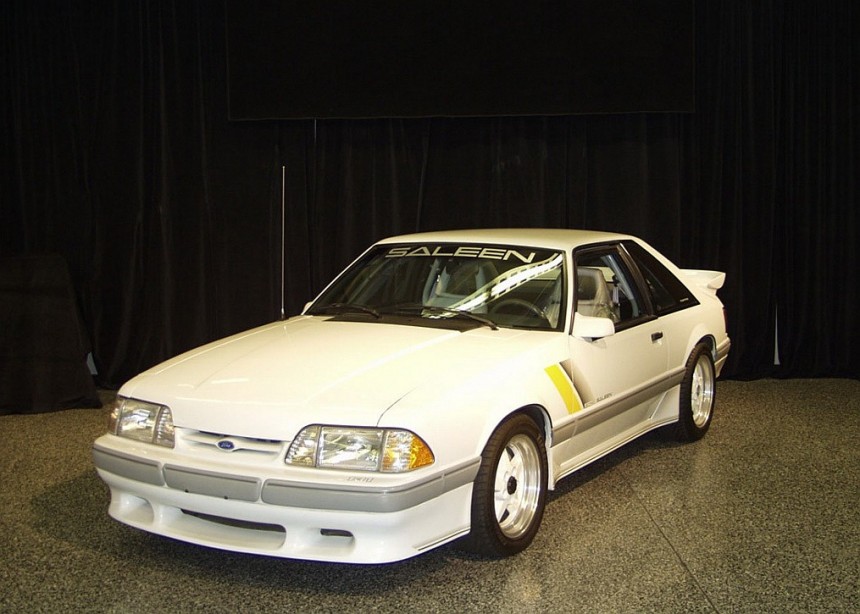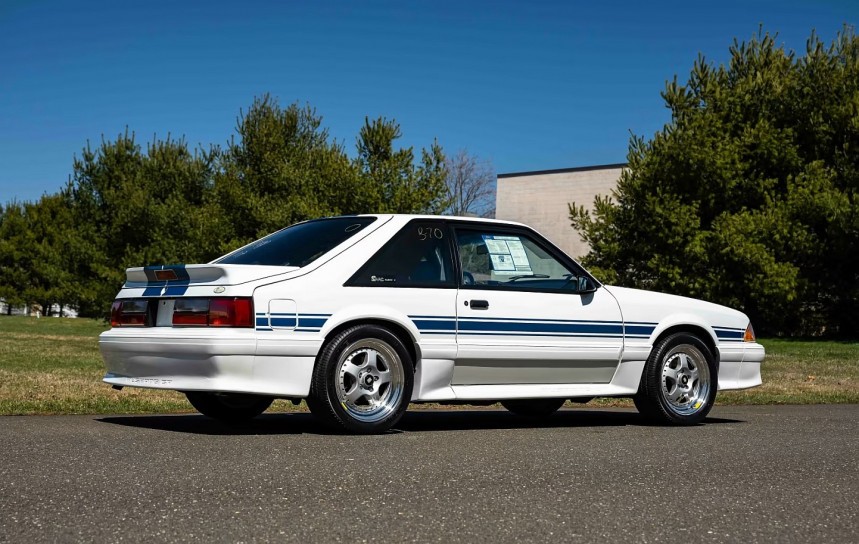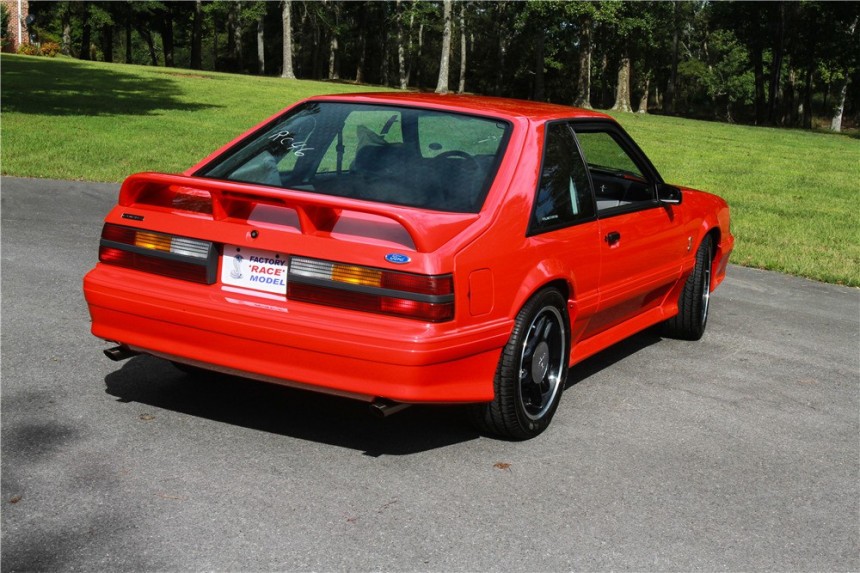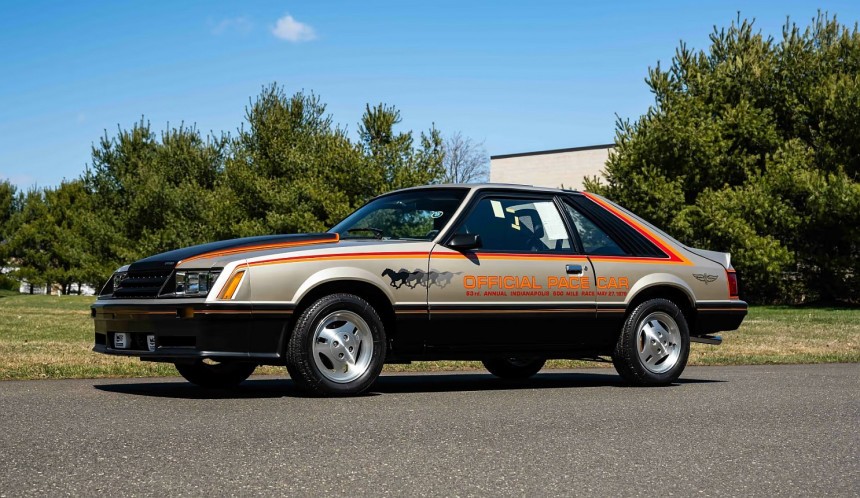Introduced in 1979 and built for a whopping 14 year timespan, the third-generation Mustang is often regarded as the car that saved the nameplate. While it wasn't as powerful as the iconic first-gen pony, the Fox body Mustang delivered solid performance for the era. Moreover, it spawned many special-edition models that proved high performance was achievable without big-block V8 engines.
Come 2023, the Fox body Mustang is becoming increasingly popular with pony car enthusiasts. As 1980s nostalgia is settling in, well-maintained examples are seen as a good investment, while rare special-edition versions are moving into the six-figure territory at public auctions. Here are the greatest (in my opinion) ten Fox body Mustangs ever made, ordered by the year they arrived in dealerships.
The Cobra is usually associated with the Cobra Jet engines of the late 1960s and the beefed-up Fox-body Mustangs introduced in 1993, but the name was also used in the 1970s and 1980s. Following the discontinuation of the Cobra Jet engine in 1971, Ford reintroduced the badge in 1976 as an appearance package called the Cobra II. It remained in production through 1978, when it was renamed King Cobra.
Ford kept the appearance package as it redesigned the Mustang for the 1979 model year. In the absence of a GT model, the Cobra was the meanest-looking iteration of the third-gen Mustang in the early years. It came with a blacked-out grille and trim, black low-body paint, dual pinstripes, and "Cobra" decals on the doors. The pony car also featured a small, non-functional hood scoop. Inside the cabin, Ford added special dash bezels and Cobra emblems.
But while it looked mean, the Cobra wasn't faster than the average Fox body. The standard 2.3-liter turbo-four came with 131 horsepower on tap, while the optional 4.9-liter V8 delivered 139 horses. Ford claimed the latter hit 60 mph (97 kph) in 8.3 seconds, while top speed reached 120 mph (193 kph). Transmission choices included a four-speed manual and a three-speed automatic.
The Cobra wasn't particularly successful, though. While Ford moved a whopping 369,936 Mustangs in 1979, the Cobra found only 17,579 customers or less than five percent of total production. But even though it's not faster than the regular 1979 Mustang, the Cobra is arguably the best-looking version and, come 2023, also among the rarest next to the Pace Car variant.
Cobra production continued through 1981 with updates such as a rear spoiler, revised front bumper, and black door handles. Deliveries dropped to 5,550 units in 1980 and 1,821 examples in 1981. The Cobra name was dropped in 1982 when Ford revived the GT.
Standard engine: 2.3-liter four-cylinder turbo
Optional engine: 4.9-liter V8
Transmission: 4-speed manual / 3-speed auto
Power: 131 / 139 HP
Torque: 135 / 243 LB-FT
0-60 MPH: 8.7 / 8.3 seconds
Top speed: 110 / 120 MPH
Production years: 1979
No. produced: 17,579
Born long before McLaren became the supercar manufacturer we know today, the M81 was developed with input from McLaren Engines. The latter was established in the US in 1969 by Bruce McLaren to operate the New Zealander's Can-Am and Indy Car racing programs.
The first major project of the newly founded Special Vehicle Operations (SVO) division, the M81 was essentially a Fox body with race-inspired looks. Add-ons included IMSA-style fender flares, wide BBS alloy wheels, functional brake ducts in the side skirts, and a rather strange-looking bulge in the front hood.
The Mustang's egg-crate grille was also covered up, with air sent under the hood via a larger opening in the lower bumper. Notably wider and more aggressive styling-wise, the M81 was finished in McLaren's iconic Papaya Orange, while the lower section was painted dark gray.
The cabin also got its fair share of upgrades, including Recaro seats and a racing steering wheel. The M81 package also included Stewart-Warner instrument gauges and a roll bar. The AC unit was removed to save weight, but Ford kept it on the options list.
A mean-looking Mustang wasn't enough in an era of horsepower restrictions, so Ford also commissioned McLaren to spice up its turbocharged, 2.3-liter four-cylinder engine. Bruce's engineers disassembled the lump, blueprinted it, ported and polished the head, and added a variable turbocharger capable of producing five to 11 PSI. The improvements increased the engine's output from 131 to 175 horsepower, while torque jumped from 137 to 145 pound-feet (186 to 197 Nm). The latter figure, however, was in the lowest boost setting.
The M81 immediately became the quickest Mustang of its era, needing only 7.9 seconds to hit 60 mph from a standing start. Its 125-mph (201-kph) top speed was also higher than any Mustang available in showrooms at the time.
Unveiled for the 1981 model year, the M81 went on sale for $25,000, more than three times more than a base Mustang and only $10,000 cheaper than a Ferrari 308. Ford hoped to sell 249 units, but the expensive sticker kept buyers away from the McLaren-made fastback. SVO and McLaren ended up making only ten units, including the prototype. As a result, the M81 is the rarest Fox-body Mustang ever produced.
Engine: 2.3-liter four-cylinder turbo
Transmission: 5-speed manual
Power: 175 HP
Torque: 145 LB-FT
0-60 MPH: 7.9 seconds
Top speed: 125 MPH
Production years: 1981
No. produced: 10
Initially introduced in 1965, the GT equipment group was retired in 1969 due to the massive success of the then-new Mach 1. The "GT" badge did not return on the Mustang until 13 years later, in 1982. Launched as a replacement for the Cobra, the GT debuted with the slogan "The Boss is Back." And indeed it was.
Featuring a re-engineered, high-output version of the 4.9-liter V8 with new valves, a more aggressive cam, a larger carburetor, and improved intake and exhaust systems, the GT arrived in showrooms with 157 horsepower on tap. Sure, it is somewhat disappointing by modern standards, but we must remember that the 1981 version of the 302 V8 generated 139 horsepower. A 13% in power was nothing to sneeze at during the Malaise Era.
Extra oomph aside, the GT also had a front air dam, fog lamps, a rear spoiler from the Pace Car, a small hood scoop, and a four-speed Tremec manual gearbox as standard. The first GT in over a decade needed 8.1 seconds to hit the 60-mph mark and topped at 118 mph (190 kph).
The nameplate's revival was a big success, with 19% of all Mustangs sold for the 1982 model year sporting the "GT" badge. That's 24,799 units. The 1982 GT is not among the fastest Mustangs on this list, but it's definitely one of the greatest, as it added heritage to the Fox-body pony car.
Engine: 4.9-liter V8
Transmission: 4-speed manual
Power: 157 HP
Torque: 240 LB-FT
0-60 MPH: 8.1 seconds
Top speed: 118 MPH
Production years: 1982
No. produced: 24,799
Short for Special Service Package, the SSP is yet another reason why the Mustang GT's return in 1982 was a big deal. Underpowered cars were a problem not just for performance car enthusiasts in the early 1980s. Police departments also had issues finding proper vehicles for pursuit duty. With big-block police cars a thing of the past and the LTD Crown Victoria too heavy for high-speed pursuits, the California Highway Patrol requests Mustangs to test as high-speed enforcement vehicles.
Having discarded the Chevrolet Camaro Z28 following an 18-month-long test, the CHP eventually chose to stick with the Mustang and ended with a fleet of 406 units. All cars were equipped with the regular 4.9-liter V8 but also featured a certified 140-mph speedometer, one-key-fits-all locking, a radio noise suppression package, and a relocated deck lid release.
In 1983, Ford made the package available to other departments, and Mustang cop cars eventually spread across the US. The output of the V8 engine increased to 175 horsepower n 1983 and 200 horses in 1986. One final update in 1989 saw oomph jump to 225 horsepower. But while many SSP vehicles featured factory engines, some were reportedly beefed up to better keep up with fast European sports cars on the highway.
Ford retired the SSP package in 1993 when Fox-body production ended. Built in some 15,000 units, the SSP is a highly desirable vehicle among Fox-body enthusiasts, mainly due to its "cop engine" appeal. Sold at auction when decommissioned, many SSP cars ended up in civilian hands. While some were restored to police-duty specifications, others were turned into hot rods.
Engine: 4.9-liter V8
Transmission: 4-speed manual
Power: 157-225 HP
Torque: 240-300 LB-FT
0-60 MPH: 6.3 seconds
Top speed: 140 mph
Production years: 1982-1993
No. produced: 15,000
The first Mustang developed entirely by the Special Vehicle Operations division, the SVO arrived in 1984 as the hottest iteration of the Fox-body pony car. Surprisingly, Ford decided to go with a beefed-up version of the 2.3-liter turbo-four instead of the more desirable V8.
Fitted with a larger turbo, an advanced fuel-injection system, and an air-to-air intercooler, the SVO's four-banger generated 175 horsepower and 210 pound-feet (285 Nm) of torque. It was just as potent as the high-output version of the V8 but lagged behind by 35 pound-feet (47 Nm) of twist. However, the engine was 150 pounds (68 kg) lighter, enabling better weight distribution and thus improving handling.
But the SVO wasn't only about extra power. Ford also gave it a modified front suspension, a limited-slip differential, ventilated four-wheel disc brakes, and unique pedals that aided heel-and-toe shifting. The adjustable KONI suspension and aluminum wheels rounded off the package.
Styling-wise, the SVO got a unique front grille and hood, a functional scoop, thinner side molds, and a biplane spoiler. Inside the cabin, it had adjustable sports seats, a leather-wrapped steering wheel, leather seats, and a flip-up sunroof. Customers who wanted to save weight could delete many of these features through the Competition Prep package. The bundle lightened the car by about 100 pounds (45 kg).
Ford upgraded the engine halfway through the 1985 model year when output increased to 205 horses and 248 pound-feet (336 Nm) of torque. In 1986, the mill lost a bit of oomph, dropping 200 horses and 240 pound-feet (325 Nm) of twist. The 1985 facelift also added "aero" headlamps and pinstriped taillights.
One of the quickest Fox-body Mustangs, the SVO accelerated from 0 to 60 mph in 7.7 seconds and hit a top speed of 144 mph (232 kph). Ford produced only 9,844 examples over three model years, which makes the SVO rare and desirable.
Engine: 2.3-liter four-cylinder turbo
Transmission: 5-speed manual
Power: 175-205 HP
Torque: 210-248 LB-FT
0-60 MPH: 7.7 seconds
Top speed: 144 MPH
Production years: 1984-1986
No. produced: 9,844
Unrelated to the M81 McLaren of the early 1980s, the Mustang ASC McLaren was essentially a tuned-up convertible crafted by American Specialty Cars, also known as the American Sunroof Company. Established in Los Angeles in 1967, ASC supplied OEM services to Ford as early as 1968. In the 1970s, it became well-known for converting standard coupe automobiles into convertibles.
In 1984, Ford joined forces with ASC to create a special version of the Mercury Capri, itself based on the Fox platform. The cars came out of ASC's shop wearing body kits, flashy paint jobs, custom wheels, and revised suspension. Notably more expensive than stock, the Capri ASC wasn't very popular, and production ended in 1986 after only 557 convertibles were made. That's when the program was shifted to the Mustang.
The ASC upgrade remained mostly an appearance package but involved more customization than the Capri. Specifically, the Mustang also got a rear-seat delete, which turned it into a two-seater, and a redesigned windshield that was raked back a further 20 degrees. ASC also included a revised body kit, a three-window soft top, and a leather interior.
Just like the Capri version, the Mustang ASC wasn't faster than the average 'Stang. The car was equipped with the regular-production 4.9-liter V8 engine, which delivered 225 horsepower and 300 pound-feet (407 Nm) of torque at the time. The ASC did ride on a sportier suspension, but its performance remained similar to the stock Mustang convertible. The ASC McLaren version remained in production until 1990, but only 1,806 units were built. I guess not many people were willing to pay the 50% premium over the standard Mustang GT.
Engine: 4.9-liter V8
Transmission: 5-speed manual
Power: 225 HP
Torque: 300 LB-FT
0-60 MPH: 6.5 seconds
Top speed: 137 MPH
Production years: 1987-1990
No. produced: 1,806
Established in 1983 as Saleen Autosport, Steve Saleen's company began selling modified Mustangs in 1984. One year later, it created the first supercharged Mustang, and in 1986 a Saleen pony car won the 24 Hours of Mosport. Steve remained heavily involved in motorsport but continued to upgrade road cars. In 1989, the year of the Mustang's 25th anniversary, Saleen introduced the SSC.
While Ford did very little to celebrate the benchmark, Saleen gave Mustang enthusiasts the most powerful Fox body at the time. Thanks to a larger throttle body, modified intake manifolds, ported heads, and a dual exhaust system, the 4.9-liter V8 delivered 290 horsepower, a whopping 65 more than the range-topping Mustang. Torque was also up from 300 to 325 pound-feet (407 to 441 Nm).
But Saleen didn't stop at the engine compartment. The SSC also got adjustable three-position shock absorbers and struts, new coil springs, a Quadra Shock rear suspension, disc brakes at all four corners, and a 3.55:1 Traction-Lok rear end. A unique body kit with a revised front bumper, side skirts, and a rear wing improved the Mustang's aerodynamics.
All told when, Steve Saleen was done with the SSC, it was a notable departure from the factory Mustang GT. Featuring a five-speed manual transmission as standard, the Saleen SSC hit 60 mph from a standing start in 5.6 seconds and reached a top speed of almost 150 mph (241 kph). It was a half-second quicker and about 15 mph faster than a stock GT. The SSC remained in production for only one year and spawned just 161 units. As a result, it's one of the rarest Mustangs on this list.
Engine: 4.9-liter V8
Transmission: 5-speed manual
Power: 290 HP
Torque: 325 LB-FT
0-60 MPH: 5.6 seconds
Top speed: 149 MPH
Production years: 1989
No. produced: 161
One quick look at the SAAC MkI, and you can't help but think about the 1965 Shelby GT350, right? Well, this Fox-body Mustang is essentially a Shelby without the iconic badges. How so? Ford and Carroll parted ways in the late 1960s and never crossed paths until the 2000s. And during the Fox-body's stint in showrooms, Shelby was busy modifying Mopars. Having a "Shelby" emblem on a Ford was impossible due to Carroll's contract with Chrysler.
But that didn't stop the Shelby American Automobile Club, part of Shelby American, from designing a beefed-up Mustang. Envisioned by SAAC bosses Ken Eber and Rick Kopec, the SAAC MkI was designed with Carroll's blessing and help from Ford's Power Products Operation Group manager, David Wagner. Using parts from the aftermarket and Ford Motorsport catalog, they assembled one of the rarest and fastest Fox-body Mustangs ever made.
The engine got substantial upgrades, including an aluminum GT40 intake, a larger throttle body, and GT40 cast-iron cylinder heads. The package also included a high-flow EGR spacer, ceramic-coated headers, and a 2.5-inch dual-exhaust system. Once completed, the beefed-up 4.9-liter V8 was good for 295 horsepower, a full 70 horses more than the 1992 Mustang GT.
To get all that oomph to the rear wheels, SAAC upgraded the T5 five-speed manual and went with a 3.27:1 rear axle. The latter was only available on automatic Mustangs from the factory but came standard on the SAAC.
As with Shelbys based on the first-gen Mustang, the SAAC was also redesigned for better handling. SAAC dropped the stock suspension in favor of Eibach variable-rate springs, adjustable Koni gas shocks, a strut-tower brace, and a four-point roll bar. And just like the Saleen version above, it got disc brakes at all four corners.
Styling-wise, the SAAC sported rather subtle changes beyond the flashy blue stripes. Upgrades included fiberglass side skirts and cold-air ducts instead of the GT's fog lamps. SAAC also adopted LX-type taillights and a rear spoiler. More importantly, the company ditched all "Ford" badging inside and out (and under the hood, too).
Performance-wise, the SAAC MkI is at the top of this list thanks to a 0-to-60-mph sprint of only 5.2 seconds and a top speed of 156 mph (251 kph).
While the SAAC MkI generated a lot of hype at the time, sales were low due to the extremely high sticker. Priced at $40,000, the MkI was pricier than a 300-horsepower Corvette. The fact that you had to be a SAAC club member to qualify to own one didn't help either. SAAC sold only 62 cars.
Engine: 4.9-liter V8
Transmission: 5-speed manual
Power: 295 HP
Torque: 326 LB-FT
0-60 MPH: 5.2 seconds
Top speed: 156 mph
Production years: 1992
No. produced: 62
1993 was the Fox-body Mustang's final year on the market. And after a 14-year-long stint in showrooms, Ford decided to give the pony car a proper send-off with the SVT Cobra. Created by the newly established SVT division, the Cobra didn't look particularly more aggressive than the GT, but it came with a heavily modified 4.9-liter V8 engine.
Souped up with GT40 high-flow cast iron heads, a unique intake manifold, a bespoke camshaft, and increased airflow, the V8 delivered 235 horsepower and 280 pound-feet of torque. The five-speed manual got custom gearing and an improved clutch, while Tokico units replaced the standard shocks and struts. All these upgrades turned the SVT Cobra into a 5.9-second car, giving it a top speed of 137 mph (220 kph).
Ford offered only four exterior colors for the Cobra: Vibrant Red Clearcoat, Vibrant Red, Teal Metallic, and black. Interior color choices included Opal Gray or black cloth and Opal Gray leather. Priced from $18,505, about 50% more than the standard GT, the SVT Cobra was produced in 4,993 units.
While not as powerful and fast as the Saleen or SAAC version, the Cobra is the second-most potent factory Fox body. Which brings me to the final entry of this list.
Engine: 4.9-liter V8
Transmission: 5-speed manual
Power: 235 HP
Torque: 280 LB-FT
0-60 MPH: 5.9 seconds
Top speed: 137 MPH
Production years: 1993
No. produced: 4,993
Designed as an SVT Cobra to end all Fox body Mustangs, the Cobra R didn't get extra oomph under the hood. However, it was lighter and better suited for track duty. The R designation eliminated many convenience features, including the radio, speakers, antenna, air conditioning, and sound-deadening material. The rear seats, rear carpeting, fog lamps, and roll-up cargo cover were also deleted to save weight.
In all, the Cobra R was 450 pounds (204 kg) lighter than the regular Cobra, but this was offset by the heavy-duty, track-ready equipment it got instead. The list included a stiffer suspension, adjustable Koni shocks and struts, vented Kelsey-Hayes brake rotors, and an engine oil cooler.
While identical to the Cobra, the Cobra R V8 featured a unique radiator and a purge tank for improved cooling. Ford also mounted a power steering cooler. Despite not having extra power, the Cobra R was a tad quicker, from 0 to 60 mph, needing 5.7 seconds to hit the benchmark. Its top speed was also slightly higher at 140 mph (225 kph).
But while the Cobra saw daylight in almost 5,000 units, Ford produced only 107 Cobra Rs, all finished in Vibrant Red Clearcoat. Most cars were purchased by private collectors, but some were raced in the SSCA series. The Cobra R is the most desirable iteration of the third-generation Mustang.
Engine: 4.9-liter V8
Transmission: 5-speed manual
Power: 235 HP
Torque: 280 LB-FT
0-60 MPH: 5.7 seconds
Top speed: 140 MPH
Production years: 1993
No. produced: 107
Some of the Pace Car's features eventually found their way into production models. The air dam and the rear spoiler, for instance, were offered in the 1980 and 1981 Cobra models. Built in 10,479, the Pace Car is nowhere near as rare as most Mustangs on this list, but its one-year-only production run and somewhat exotic looks make it a desirable Fox body.
Standard engine: 2.3-liter turbo four-cylinder
Optional engine: 4.9-liter V8
Transmission: 4-speed manual / 3-speed auto
Power: 131 / 139 HP
Torque: 135 / 243 LB-FT
0-60 MPH: 8.7 / 8.3 seconds
Top speed: 110 / 120 MPH
Production years: 1979
No. produced: 10,479
1979 Ford Mustang Cobra
Ford kept the appearance package as it redesigned the Mustang for the 1979 model year. In the absence of a GT model, the Cobra was the meanest-looking iteration of the third-gen Mustang in the early years. It came with a blacked-out grille and trim, black low-body paint, dual pinstripes, and "Cobra" decals on the doors. The pony car also featured a small, non-functional hood scoop. Inside the cabin, Ford added special dash bezels and Cobra emblems.
But while it looked mean, the Cobra wasn't faster than the average Fox body. The standard 2.3-liter turbo-four came with 131 horsepower on tap, while the optional 4.9-liter V8 delivered 139 horses. Ford claimed the latter hit 60 mph (97 kph) in 8.3 seconds, while top speed reached 120 mph (193 kph). Transmission choices included a four-speed manual and a three-speed automatic.
The Cobra wasn't particularly successful, though. While Ford moved a whopping 369,936 Mustangs in 1979, the Cobra found only 17,579 customers or less than five percent of total production. But even though it's not faster than the regular 1979 Mustang, the Cobra is arguably the best-looking version and, come 2023, also among the rarest next to the Pace Car variant.
Cobra production continued through 1981 with updates such as a rear spoiler, revised front bumper, and black door handles. Deliveries dropped to 5,550 units in 1980 and 1,821 examples in 1981. The Cobra name was dropped in 1982 when Ford revived the GT.
Standard engine: 2.3-liter four-cylinder turbo
Optional engine: 4.9-liter V8
Transmission: 4-speed manual / 3-speed auto
Power: 131 / 139 HP
Torque: 135 / 243 LB-FT
0-60 MPH: 8.7 / 8.3 seconds
Top speed: 110 / 120 MPH
Production years: 1979
No. produced: 17,579
1981 Ford Mustang McLaren M81
The first major project of the newly founded Special Vehicle Operations (SVO) division, the M81 was essentially a Fox body with race-inspired looks. Add-ons included IMSA-style fender flares, wide BBS alloy wheels, functional brake ducts in the side skirts, and a rather strange-looking bulge in the front hood.
The Mustang's egg-crate grille was also covered up, with air sent under the hood via a larger opening in the lower bumper. Notably wider and more aggressive styling-wise, the M81 was finished in McLaren's iconic Papaya Orange, while the lower section was painted dark gray.
The cabin also got its fair share of upgrades, including Recaro seats and a racing steering wheel. The M81 package also included Stewart-Warner instrument gauges and a roll bar. The AC unit was removed to save weight, but Ford kept it on the options list.
A mean-looking Mustang wasn't enough in an era of horsepower restrictions, so Ford also commissioned McLaren to spice up its turbocharged, 2.3-liter four-cylinder engine. Bruce's engineers disassembled the lump, blueprinted it, ported and polished the head, and added a variable turbocharger capable of producing five to 11 PSI. The improvements increased the engine's output from 131 to 175 horsepower, while torque jumped from 137 to 145 pound-feet (186 to 197 Nm). The latter figure, however, was in the lowest boost setting.
The M81 immediately became the quickest Mustang of its era, needing only 7.9 seconds to hit 60 mph from a standing start. Its 125-mph (201-kph) top speed was also higher than any Mustang available in showrooms at the time.
Unveiled for the 1981 model year, the M81 went on sale for $25,000, more than three times more than a base Mustang and only $10,000 cheaper than a Ferrari 308. Ford hoped to sell 249 units, but the expensive sticker kept buyers away from the McLaren-made fastback. SVO and McLaren ended up making only ten units, including the prototype. As a result, the M81 is the rarest Fox-body Mustang ever produced.
Engine: 2.3-liter four-cylinder turbo
Transmission: 5-speed manual
Power: 175 HP
Torque: 145 LB-FT
0-60 MPH: 7.9 seconds
Top speed: 125 MPH
Production years: 1981
No. produced: 10
1982 Ford Mustang GT
Featuring a re-engineered, high-output version of the 4.9-liter V8 with new valves, a more aggressive cam, a larger carburetor, and improved intake and exhaust systems, the GT arrived in showrooms with 157 horsepower on tap. Sure, it is somewhat disappointing by modern standards, but we must remember that the 1981 version of the 302 V8 generated 139 horsepower. A 13% in power was nothing to sneeze at during the Malaise Era.
Extra oomph aside, the GT also had a front air dam, fog lamps, a rear spoiler from the Pace Car, a small hood scoop, and a four-speed Tremec manual gearbox as standard. The first GT in over a decade needed 8.1 seconds to hit the 60-mph mark and topped at 118 mph (190 kph).
The nameplate's revival was a big success, with 19% of all Mustangs sold for the 1982 model year sporting the "GT" badge. That's 24,799 units. The 1982 GT is not among the fastest Mustangs on this list, but it's definitely one of the greatest, as it added heritage to the Fox-body pony car.
Engine: 4.9-liter V8
Transmission: 4-speed manual
Power: 157 HP
Torque: 240 LB-FT
0-60 MPH: 8.1 seconds
Top speed: 118 MPH
Production years: 1982
No. produced: 24,799
1982 Ford Mustang SSP
Having discarded the Chevrolet Camaro Z28 following an 18-month-long test, the CHP eventually chose to stick with the Mustang and ended with a fleet of 406 units. All cars were equipped with the regular 4.9-liter V8 but also featured a certified 140-mph speedometer, one-key-fits-all locking, a radio noise suppression package, and a relocated deck lid release.
In 1983, Ford made the package available to other departments, and Mustang cop cars eventually spread across the US. The output of the V8 engine increased to 175 horsepower n 1983 and 200 horses in 1986. One final update in 1989 saw oomph jump to 225 horsepower. But while many SSP vehicles featured factory engines, some were reportedly beefed up to better keep up with fast European sports cars on the highway.
Ford retired the SSP package in 1993 when Fox-body production ended. Built in some 15,000 units, the SSP is a highly desirable vehicle among Fox-body enthusiasts, mainly due to its "cop engine" appeal. Sold at auction when decommissioned, many SSP cars ended up in civilian hands. While some were restored to police-duty specifications, others were turned into hot rods.
Engine: 4.9-liter V8
Transmission: 4-speed manual
Power: 157-225 HP
Torque: 240-300 LB-FT
0-60 MPH: 6.3 seconds
Top speed: 140 mph
Production years: 1982-1993
No. produced: 15,000
1984 Ford Mustang SVO
Fitted with a larger turbo, an advanced fuel-injection system, and an air-to-air intercooler, the SVO's four-banger generated 175 horsepower and 210 pound-feet (285 Nm) of torque. It was just as potent as the high-output version of the V8 but lagged behind by 35 pound-feet (47 Nm) of twist. However, the engine was 150 pounds (68 kg) lighter, enabling better weight distribution and thus improving handling.
But the SVO wasn't only about extra power. Ford also gave it a modified front suspension, a limited-slip differential, ventilated four-wheel disc brakes, and unique pedals that aided heel-and-toe shifting. The adjustable KONI suspension and aluminum wheels rounded off the package.
Styling-wise, the SVO got a unique front grille and hood, a functional scoop, thinner side molds, and a biplane spoiler. Inside the cabin, it had adjustable sports seats, a leather-wrapped steering wheel, leather seats, and a flip-up sunroof. Customers who wanted to save weight could delete many of these features through the Competition Prep package. The bundle lightened the car by about 100 pounds (45 kg).
Ford upgraded the engine halfway through the 1985 model year when output increased to 205 horses and 248 pound-feet (336 Nm) of torque. In 1986, the mill lost a bit of oomph, dropping 200 horses and 240 pound-feet (325 Nm) of twist. The 1985 facelift also added "aero" headlamps and pinstriped taillights.
One of the quickest Fox-body Mustangs, the SVO accelerated from 0 to 60 mph in 7.7 seconds and hit a top speed of 144 mph (232 kph). Ford produced only 9,844 examples over three model years, which makes the SVO rare and desirable.
Engine: 2.3-liter four-cylinder turbo
Transmission: 5-speed manual
Power: 175-205 HP
Torque: 210-248 LB-FT
0-60 MPH: 7.7 seconds
Top speed: 144 MPH
Production years: 1984-1986
No. produced: 9,844
1987 Ford Mustang ASC McLaren
In 1984, Ford joined forces with ASC to create a special version of the Mercury Capri, itself based on the Fox platform. The cars came out of ASC's shop wearing body kits, flashy paint jobs, custom wheels, and revised suspension. Notably more expensive than stock, the Capri ASC wasn't very popular, and production ended in 1986 after only 557 convertibles were made. That's when the program was shifted to the Mustang.
The ASC upgrade remained mostly an appearance package but involved more customization than the Capri. Specifically, the Mustang also got a rear-seat delete, which turned it into a two-seater, and a redesigned windshield that was raked back a further 20 degrees. ASC also included a revised body kit, a three-window soft top, and a leather interior.
Just like the Capri version, the Mustang ASC wasn't faster than the average 'Stang. The car was equipped with the regular-production 4.9-liter V8 engine, which delivered 225 horsepower and 300 pound-feet (407 Nm) of torque at the time. The ASC did ride on a sportier suspension, but its performance remained similar to the stock Mustang convertible. The ASC McLaren version remained in production until 1990, but only 1,806 units were built. I guess not many people were willing to pay the 50% premium over the standard Mustang GT.
Engine: 4.9-liter V8
Transmission: 5-speed manual
Power: 225 HP
Torque: 300 LB-FT
0-60 MPH: 6.5 seconds
Top speed: 137 MPH
Production years: 1987-1990
No. produced: 1,806
1989 Saleen SSC
While Ford did very little to celebrate the benchmark, Saleen gave Mustang enthusiasts the most powerful Fox body at the time. Thanks to a larger throttle body, modified intake manifolds, ported heads, and a dual exhaust system, the 4.9-liter V8 delivered 290 horsepower, a whopping 65 more than the range-topping Mustang. Torque was also up from 300 to 325 pound-feet (407 to 441 Nm).
But Saleen didn't stop at the engine compartment. The SSC also got adjustable three-position shock absorbers and struts, new coil springs, a Quadra Shock rear suspension, disc brakes at all four corners, and a 3.55:1 Traction-Lok rear end. A unique body kit with a revised front bumper, side skirts, and a rear wing improved the Mustang's aerodynamics.
All told when, Steve Saleen was done with the SSC, it was a notable departure from the factory Mustang GT. Featuring a five-speed manual transmission as standard, the Saleen SSC hit 60 mph from a standing start in 5.6 seconds and reached a top speed of almost 150 mph (241 kph). It was a half-second quicker and about 15 mph faster than a stock GT. The SSC remained in production for only one year and spawned just 161 units. As a result, it's one of the rarest Mustangs on this list.
Engine: 4.9-liter V8
Transmission: 5-speed manual
Power: 290 HP
Torque: 325 LB-FT
0-60 MPH: 5.6 seconds
Top speed: 149 MPH
Production years: 1989
No. produced: 161
1992 SAAC MkI
But that didn't stop the Shelby American Automobile Club, part of Shelby American, from designing a beefed-up Mustang. Envisioned by SAAC bosses Ken Eber and Rick Kopec, the SAAC MkI was designed with Carroll's blessing and help from Ford's Power Products Operation Group manager, David Wagner. Using parts from the aftermarket and Ford Motorsport catalog, they assembled one of the rarest and fastest Fox-body Mustangs ever made.
The engine got substantial upgrades, including an aluminum GT40 intake, a larger throttle body, and GT40 cast-iron cylinder heads. The package also included a high-flow EGR spacer, ceramic-coated headers, and a 2.5-inch dual-exhaust system. Once completed, the beefed-up 4.9-liter V8 was good for 295 horsepower, a full 70 horses more than the 1992 Mustang GT.
To get all that oomph to the rear wheels, SAAC upgraded the T5 five-speed manual and went with a 3.27:1 rear axle. The latter was only available on automatic Mustangs from the factory but came standard on the SAAC.
As with Shelbys based on the first-gen Mustang, the SAAC was also redesigned for better handling. SAAC dropped the stock suspension in favor of Eibach variable-rate springs, adjustable Koni gas shocks, a strut-tower brace, and a four-point roll bar. And just like the Saleen version above, it got disc brakes at all four corners.
Styling-wise, the SAAC sported rather subtle changes beyond the flashy blue stripes. Upgrades included fiberglass side skirts and cold-air ducts instead of the GT's fog lamps. SAAC also adopted LX-type taillights and a rear spoiler. More importantly, the company ditched all "Ford" badging inside and out (and under the hood, too).
Performance-wise, the SAAC MkI is at the top of this list thanks to a 0-to-60-mph sprint of only 5.2 seconds and a top speed of 156 mph (251 kph).
While the SAAC MkI generated a lot of hype at the time, sales were low due to the extremely high sticker. Priced at $40,000, the MkI was pricier than a 300-horsepower Corvette. The fact that you had to be a SAAC club member to qualify to own one didn't help either. SAAC sold only 62 cars.
Engine: 4.9-liter V8
Transmission: 5-speed manual
Power: 295 HP
Torque: 326 LB-FT
0-60 MPH: 5.2 seconds
Top speed: 156 mph
Production years: 1992
No. produced: 62
1993 Ford Mustang SVT Cobra
Souped up with GT40 high-flow cast iron heads, a unique intake manifold, a bespoke camshaft, and increased airflow, the V8 delivered 235 horsepower and 280 pound-feet of torque. The five-speed manual got custom gearing and an improved clutch, while Tokico units replaced the standard shocks and struts. All these upgrades turned the SVT Cobra into a 5.9-second car, giving it a top speed of 137 mph (220 kph).
Ford offered only four exterior colors for the Cobra: Vibrant Red Clearcoat, Vibrant Red, Teal Metallic, and black. Interior color choices included Opal Gray or black cloth and Opal Gray leather. Priced from $18,505, about 50% more than the standard GT, the SVT Cobra was produced in 4,993 units.
While not as powerful and fast as the Saleen or SAAC version, the Cobra is the second-most potent factory Fox body. Which brings me to the final entry of this list.
Engine: 4.9-liter V8
Transmission: 5-speed manual
Power: 235 HP
Torque: 280 LB-FT
0-60 MPH: 5.9 seconds
Top speed: 137 MPH
Production years: 1993
No. produced: 4,993
1993 Ford Mustang SVT Cobra R
In all, the Cobra R was 450 pounds (204 kg) lighter than the regular Cobra, but this was offset by the heavy-duty, track-ready equipment it got instead. The list included a stiffer suspension, adjustable Koni shocks and struts, vented Kelsey-Hayes brake rotors, and an engine oil cooler.
While identical to the Cobra, the Cobra R V8 featured a unique radiator and a purge tank for improved cooling. Ford also mounted a power steering cooler. Despite not having extra power, the Cobra R was a tad quicker, from 0 to 60 mph, needing 5.7 seconds to hit the benchmark. Its top speed was also slightly higher at 140 mph (225 kph).
But while the Cobra saw daylight in almost 5,000 units, Ford produced only 107 Cobra Rs, all finished in Vibrant Red Clearcoat. Most cars were purchased by private collectors, but some were raced in the SSCA series. The Cobra R is the most desirable iteration of the third-generation Mustang.
Engine: 4.9-liter V8
Transmission: 5-speed manual
Power: 235 HP
Torque: 280 LB-FT
0-60 MPH: 5.7 seconds
Top speed: 140 MPH
Production years: 1993
No. produced: 107
Bonus - 1979 Ford Mustang Indianapolis Pace Car
Just like the 1979 Cobra, the Indy Pace Car edition does not have any performance enhancements. However, it sported a cool, two-tone livery and a few unique design features. These included a modified front air dam, a full-length hood scoop, and a brand-new rear spoiler. Inside the cabin, Ford added Recaro seats with patterned black and white inserts. While the actual Indy 500 pace cars got a T-top roof layout, the production version was only offered with a sunroof.Some of the Pace Car's features eventually found their way into production models. The air dam and the rear spoiler, for instance, were offered in the 1980 and 1981 Cobra models. Built in 10,479, the Pace Car is nowhere near as rare as most Mustangs on this list, but its one-year-only production run and somewhat exotic looks make it a desirable Fox body.
Standard engine: 2.3-liter turbo four-cylinder
Optional engine: 4.9-liter V8
Transmission: 4-speed manual / 3-speed auto
Power: 131 / 139 HP
Torque: 135 / 243 LB-FT
0-60 MPH: 8.7 / 8.3 seconds
Top speed: 110 / 120 MPH
Production years: 1979
No. produced: 10,479
